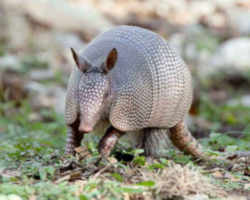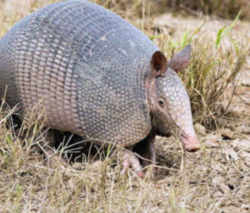
Texas Symbols
Texas State Small Mammal
Armadillo

(Dasypus novemcinctus)
Adopted in June 16, 1995.
The armadillo, (Dasypus novemcinctus,) became the official small state mammal of Texas when Governor George W. Bush signed House Concurrent Resolution No. 178 on June 16, 1995. The same resolution named the longhorn the official large state mammal of the State of Texas. Though not specified in House Concurrent Resolution No. 178, we assume that the nine-banded armadillo (Dasypus novemcinctus) is the species legislators were referring to when they named the armadillo the official small state mammal of Texas. It is commonly found as far north and east as Oklahoma and Mississippi.
Texas State Small Mammal: Armadillo

The nine-banded armadillo, a relatively recent addition to the Texas fauna, is the only species of armadillo that occurs in North America, the other twenty or so species of Dasypodidae being restricted to South and Central America. The Texas armadillo is about the size of a large cat; its overall length is about 2? feet, and adults weigh from twelve to seventeen pounds. Mature females mate in late summer and autumn and give birth to identical quadruplets the following spring. The armadillo's diet consists chiefly of insects, grubs, and spiders, though it also eats such foods as earthworms, small amphibians, and reptiles.
Characteristics of the Texas Armadillo
Body Length: 15-17 in. Tail: 14-16 in. Weight: 8-17 lbs.
The Nine-banded Armadillo is a cat-sized, armored, insect-eating mammal. Similar in form to an anteater, the bony, scaled shell of the armadillo protects it from attacks by predators. Unfortunately, armadillos often fall victim to automobiles and are frequently found dead on roadsides.
A prolific digger, armadillos dig many burrows, as well as dig for food. Distribution is often determined by soil conditions, since the animal will not survive in areas where the soil is too hard to dig. Many other wildlife species use and benefit from these abandoned burrows.
Although occasionally considered a nuisance by home owners, the armadillo's habit of digging up lawns is driven by its appetite for grubs, which can also harm lawns.
Life History
Eats insects and other invertebrates. Skilled at digging for grubs. Occasionally eats berries and bird eggs.
Although breeding occurs in July, the embryo remains in a dormant state until November. Four young are born in a burrow in March. All four young, always of the same sex, are identical quadruplets and developed from the same egg. They even share a single placenta while in the womb. Armadillos are the only mammals in which multiple young form from a single egg with any regularity.
Habitat and Distribution
The armadillo is the state mammal of Texas. Originally native to South America, the armadillo now ranges as far north as Texas, Oklahoma, Kansas and Louisiana. Found in all but the western Trans-Pecos portion of Texas in a variety of habitats; brush, woods, scrub and grasslands.
House Concurrent Resolution No. 178, 74th Legislature, Regular Session (1995)
The armadillo became the official small state mammal of Texas when Governor George W. Bush signed House Concurrent Resolution No. 178 on June 16, 1995. The same resolution named the longhorn the official large state mammal ;of the State of Texas.
HOUSE CONCURRENT RESOLUTION
By Hunter of Taylor
H.C.R. No. 178
WHEREAS, The State of Texas traditionally has recognized a variety of official state symbols as tangible representations of the proud spirit and heritage
of our state; and
WHEREAS, The bluebonnet, the pecan tree, the Guadalupe bass, and the lightning whelk are examples of some natural specimens that serve to symbolize
the great diversity of the Texas landscape, while the state dish, chili, fittingly represents another aspect of our shared culture as Texans; and
WHEREAS, In keeping with this custom, the designation of an Official State Mammal of Texas has been the subject of an extensive statewide mock election
participated in by hundreds of elementary school children throughout our state; and
WHEREAS, The two front-runners in this race have been the armadillo and the longhorn; and
WHEREAS, Once the cornerstone of the Texas cattle industry, an estimated 10 million longhorns were herded from Texas to midwestern and western markets
during the quarter century that followed the Civil War, providing invaluable stability to the state's postwar economy; and
WHEREAS, The longhorn's distinctive profile commands an immediate association with the State of Texas nationwide and is fittingly used as a visual
symbol by businesses from the Rio Grande Valley to the Panhandle; and
WHEREAS, The other candidate for designation as Official State Mammal, the armadillo, is a hardy, pioneering creature that chose to begin migrating
here at about the time that Texas became a state; and
WHEREAS, the armadillo possesses many remarkable and unique traits, some of which parallel the attributes that distinguish a true Texan, such as a
deep respect and need for the land, the ability to change and adapt, and a fierce undying love for freedom; and
WHEREAS, As proud and indomitable as the state from which they hail, both the longhorn and the armadillo will serve as fitting symbols of Texas' unique
heritage; now, therefore, be it
RESOLVED, That the 74th Legislature of the State of Texas hereby designate the longhorn the official Large State Mammal of Texas and the armadillo
the official Small State Mammal of Texas.
House Concurrent Resolution No. 178, 74th Legislature, Regular Session (1995)
Texas Law
The armadillo was named the official small state mammal of the State of Texas by House Concurrent Resolution and is not, therefore,
listed in the Texas Statutes.
Only a few of Texas' myriad symbols were actually adopted by an act of the legislature and written into the Texas Statutes.
Taxonomic Hierarchy: Armadillo
Kingdom: Animalia
Phylum: Chordata
Class: Mammalia
Order: Cingulata
Family: Dasypodidae
Subfamily: Dasypodinae
Genus: Dasypus
Species: D. novemcinctus







